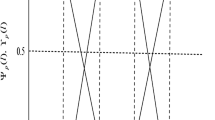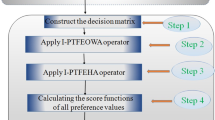Abstract
The aim of this paper is to investigate information aggregation methods under interval-valued Pythagorean trapezoidal fuzzy environment. Some Einstein operational laws on interval-valued Pythagorean trapezoidal fuzzy numbers are defined based on Einstein sum and Einstein product. Based on Einstein operations, we define interval-valued Pythagorean trapezoidal fuzzy aggregation operators, such as interval-valued Pythagorean trapezoidal fuzzy Einstein weighted geometric operator, interval-valued Pythagorean trapezoidal fuzzy Einstein ordered weighted geometric operator and interval-valued Pythagorean trapezoidal fuzzy Einstein hybrid geometric operator. Furthermore, we apply the proposed aggregation operators to deal with multiple attribute group decision making problem. Finally we construct a numerical example for multiple attribute group decision making problem and compare the result with existing methods.





Similar content being viewed by others
References
Atanassov KT (1986) Intuitionistic fuzzy sets. Fuzzy Sets Syst 20(1):87–96
Atanassov KT (1996) An equality between intuitionistic fuzzy sets. Fuzzy Sets Syst 79(2):257–258
Ban AI, Tuse DA (2014) Trapezoidal/triangular intuitionistic fuzzy numbers versus interval-valued trapezoidal/triangular fuzzy numbers and applications to multicriteria decision making methods. In: International conference on intuitionistic fuzzy sets, Sofia, pp 10–11
Ban A (2008) Trapezoidal approximations of intuitionistic fuzzy numbers expressed by value, ambiguity, width and weighted expected value. Notes Intuitionistic Fuzzy Sets 14(1):38–47
Chen TY (2018) An interval-valued Pythagorean fuzzy outranking method with a closeness-based assignment model for multiple criteria decision making. Int J Intell Syst 33(1):126–168
Deschrijver G, Kerre EE (2002) A generalization of operators on intuitionistic fuzzy sets using triangular norms and conorms. Notes Intuitionistic Fuzzy Sets 8(1):19–27
Garg H (2016) A new generalized pythagorean fuzzy information aggregation using einstein operations and its application to decision making. Int J Intell Syst 31(9):886–920
Jianqiang W, Zhong Z (2009) Aggregation operators on intuitionistic trapezoidal fuzzy number and its application to multi-criteria decision making problems. J Syst Eng Electron 20(2):321–326
Liang X, Wei C (2014) An Atanassov’s intuitionistic fuzzy multi-attribute group decision making method based on entropy and similarity measure. Int J Mach Learn Cybern 5(3):435–444
Liang D, Zhang Y, Xu Z, Darko AP (2018) Pythagorean fuzzy Bonferroni mean aggregation operator and its accelerative calculating algorithm with the multithreading. Int J Intell Syst 33(3):615–633
Liang D, Xu Z, Liu D, Wu Y (2018) Method for three-way decisions using ideal TOPSIS solutions at pythagorean fuzzy information. Inf Sci 435:282–295
Liu Y, Qin Y, Han Y (2018) Multiple criteria decision making with probabilities in interval-valued Pythagorean fuzzy setting. Int J Fuzzy Syst 20(2):558–571
Lowen R (1996) Fuzzy real numbers. In: Lowen R (ed) Fuzzy set theory. Springer, Dordrecht, pp 143–168
Peng X, Yang Y (2015) Some results for Pythagorean fuzzy sets. Int J Intell Syst 30(11):1133–1160
Rahman K, Abdullah S, Husain F, Khan MA, Shakeel M (2017) Pythagorean fuzzy ordered weighted geometric aggregation operator and their application to multiple attribute group decision making. J Appl Environ Biol Sci 7(4):67–83
Rahman K, Khan MA, Ullah M, Fahmi A (2017) Multiple attribute group decision making for plant location selection with Pythagorean fuzzy weighted geometric aggregation operator. Nucleus 54(1):66–74
Rahman K, Abdullah S, Ahmed R, Ullah M (2017) Pythagorean fuzzy Einstein weighted geometric aggregation operator and their application to multiple attribute group decision making. J Intell Fuzzy Syst 33(1):635–647
Rahman K, Abdullah S, Shakeel M, Khan MSA, Ullah M (2017) Interval-valued Pythagorean fuzzy geometric aggregation operators and their application to group decision making problem. Cogent Math Stat 4(1):1338638
Shakeel M, Abdullah S, Khan MSA, Rahman K (2018) Averaging aggregation operators with interval Pythagorean trapezoidal fuzzy numbers and their application to group decision making. Punjab Univ J Math 50(2):147–170
Wan SP, Dong JY (2010) Method of intuitionistic trapezoidal fuzzy number for multi-attribute group decision. Control Decis 25(5):773–776
Wan SP (2013) Power average operators of trapezoidal intuitionistic fuzzy numbers and application to multi-attribute group decision making. Appl Math Model 37(6):4112–4126
Wang J, Zhang Z (2009) Multi-criteria decision-making method with incomplete certain information based on intuitionistic fuzzy number. Control Decis 24(2):226–230
Wang W, Liu X (2011) Intuitionistic fuzzy geometric aggregation operators based on Einstein operations. Int J Intell Syst 26(11):1049–1075
Wang W, Liu X (2012) Intuitionistic fuzzy information aggregation using Einstein operations. IEEE Trans Fuzzy Syst 20(5):923–938
Wei G, Lu M (2018) Pythagorean fuzzy power aggregation operators in multiple attribute decision making. Int J Intell Syst 33(1):169–186
Wei G (2010) Some arithmetic aggregation operators with intuitionistic trapezoidal fuzzy numbers and their application to group decision making. J Comput 5(3):345–351
Wu J, Cao QW (2013) Same families of geometric aggregation operators with intuitionistic trapezoidal fuzzy numbers. Appl Math Model 37(1–2):318–327
Xu Z (2005) An overview of methods for determining OWA weights. Int J Intell Syst 20(8):843–865
Xu Z, Yager RR (2006) Some geometric aggregation operators based on intuitionistic fuzzy sets. Int J Gen Syst 35(4):417–433
Xu Z (2007) Intuitionistic fuzzy aggregation operators. IEEE Trans Fuzzy Syst 15(6):1179–1187
Yager RR (2013) Pythagorean fuzzy subsets. In: IFSA world congress and NAFIPS annual meeting (IFSA/NAFIPS) IEE, Joint, pp 57–61
Yager RR, Abbasov AM (2013) Pythagorean membership grades, complex numbers, and decision making. Int J Intell Syst 28(5):436–452
Yager RR (2014) Pythagorean membership grades in multicriteria decision making. IEEE Trans Fuzzy Syst 22(4):958–965
Zadeh LA (1965) Fuzzy sets. Inf Control 8(3):338–353
Zeng S, Mu Z, Baležentis T (2018) A novel aggregation method for Pythagorean fuzzy multiple attribute group decision making. Int J Intell Syst 33(3):573–585
Zhao X, Wei G (2013) Some intuitionistic fuzzy Einstein hybrid aggregation operators and their application to multiple attribute decision making. Knowl Based Syst 37:472–479
Zhang S, Yu D (2014) Some geometric Choquet aggregation operators using Einstein operations under intuitionistic fuzzy environment. J Intell Fuzzy Syst 26(1):491–500
Zhang X, Xu Z (2014) Extension of TOPSIS to multiple criteria decision making with Pythagorean fuzzy sets. Int J Intell Syst 29(12):1061–1078
Zhao S, Liang C, Zhang J (2015) Some intuitionistic trepozoidal aggregation fuzzy aggregation operators based on Einstein operations and their application in multiple attribute group decision making. Int J Mach Learn Cybern 8(2):547–569
Zhang X (2016) Multicriteria Pythagorean fuzzy decision analysis: a hierarchical QUALIFLEX approach with the closeness index-based ranking methods. Inf Sci 330:104–124
Zhang X (2016) A novel approach based on similarity measure for Pythagorean fuzzy multiple criteria group decision making. Int J Intell Syst 31(6):593–611
Author information
Authors and Affiliations
Corresponding author
Additional information
Publisher’s Note
Springer Nature remains neutral with regard to jurisdictional claims in published maps and institutional affiliations.
Rights and permissions
About this article
Cite this article
Shakeel, M., Abdullah, S., Shahzad, M. et al. Geometric aggregation operators with interval-valued Pythagorean trapezoidal fuzzy numbers based on Einstein operations and their application in group decision making. Int. J. Mach. Learn. & Cyber. 10, 2867–2886 (2019). https://doi.org/10.1007/s13042-018-00909-y
Received:
Accepted:
Published:
Issue Date:
DOI: https://doi.org/10.1007/s13042-018-00909-y




